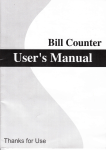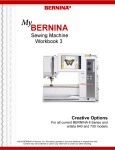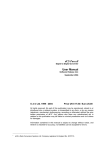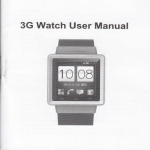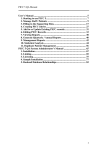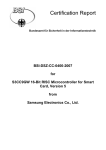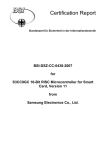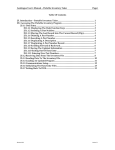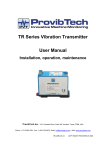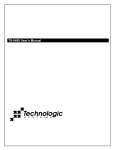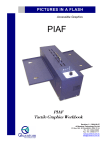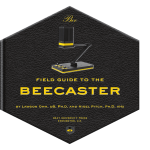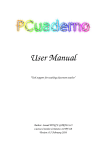Download Texas Instruments TM990/189, 99/4, TI58, TI59
Transcript
IT 1 teaching system uses 16-bit CPU Just released in Australia, the Texas Instruments TM990/189 single-board microcomputer is intended primarily for teaching in colleges, universities and industry. It comes with comprehensive manuals, and can be used either with or without an external terminal. Of particular interest is the microprocessor it uses, which is a 40-pin version of TI's powerful 16-bit TMS9900 processor. by JAMIESON ROWE Superficially, the TM990/189 looks much the same as other single-board microcomputer systems intended for teaching and evaluation. It comes as a 280 x 207mm PCB which is provided with rubber feet on the underside, and obviously meant to be used "naked". But it doesn't take long to find out that there's more to the system than meets the eye. Like other small systems, it has an onboard keyboard and LED display. In this case they are provided in the form of a modified "top half" from one of TI's calculators, giving the keyboard no less than 45 keys. One of these is used as a shift key, so that the total number of key functions available is no less than 88, of which 63 are actually used. TI has taken advantage of the keyboard by using it for full alphanumeric intput. This means that they also have to use the LED display for alphanumerics despite the fact that the LEDs are only 7-segment calculator readouts. So some of the characters look a little weird (K, M, R, V and W, for example!), while the others jump from upper to lower case and back again as you go along. But you get used to them after a while, and it does save money. A circular piezoelectric audio indicator on the board next to the display gives the system the ability to attract the user's attention. The next thing you discover upon reading through the user manual is that the system has an audio cassette interface on board, complete with optional motor control for the recorder. The interface uses the two tone FSK method, with tones of 1200 and 2400Hz — which should make it at least nominally compatible with systems using the "Kansas City/Byte" standard. On the memory 'side, the system comes with 1K bytes of RAM which may be expanded to 2K bytes by merely plugging in another pair of chips. It also comes with 4K bytes of ROM, and this contains a resident monitor/debug program called UNIBUG. Along with the monitor, the ROM also contains — wait for it — a symbolic assembler! Not a full-scale multipass assembler with all the frills, to be sure, but a very useful little interactive assembler none the less. It offers the ability to use both forward -- and backward — referenced labels, a current location symbol, and six pseudo-op directives: ORG, BSS (reserve a block of memory), DATA, EQU, TEXT (ASCII string storage) and END. Needless to say this makes the TM990/189 much more attractive than earlier single board systems, which you had to program in hex. It is far easier, faster and more convenient to be able to program in symbolic language, whether you're learning or using the system for development work. Incidentally you aren't limited to using the assembler with the on-board keyboard and display, either. Both the assembler and the monitor have routines for communicating with a normal external terminal; all you need to do this is wire up the appropriate hardware option on the board. Only a couple of ICs and a few other parts are required to wire up the serial interface option, and you can configure it for either RS232C or 20mA current loop. The firmware driver routines work at either 110 or 300baud, as required. It left is the complete TM990/189 training system — note he keyboard/display using converted calculator hardware. r-he two training manuals which accompany the system are hown above. ELECTRONICS Australia, July, 1979 81 Ti teaching system uses 16-bit CPU Also provided on the TM900/189 board are a 16-bit parallel I/O port, a bus interface for off-board memory expansion, and provision for off-board expansion of the parallel I/O facilities to a total of 512 bits (32 x 8). There is also a socket for an optional 2K byte ROM or EPROM. Along with the system.. hardware come two quite comprehensive manuals. One is a User 'Manual, the other an Introduction to Microprocessors training manual which uses the TM090/189 system as the basis for its treatment. Both books are unbound softcover editions, with the pages A4 size. One measures about 15mm thick while the other is about 421-nm thick and has 500-odd pages. Both books are packed full of information, and together they provide comprehensive training material. Their organisation is not as good as the best I have seen, however, and I get the impression that they have been put together rather hastily. This suggests that colleges may need to augment and/or guide students through the material, at least until they have gained a basic familiarity. Despite this qualification I think the TM990/189 will be of considerable interest as a training system, if only because of its flexibility. It is also likely to be of interest as a low cost development system, by virtue of the fact that it is based on the TI 16-bit TMS9980A microprocessor. Actually the TMS9980A is a particularly interesting micro, because it is virtually a 40-pin version of TI's powerful TMS9900 processor — which normally comes in a whopping 64-pin package. How has TI managed to do without 24 of the pins, in order to get the processor into a 40-pin package? The answer is by pulling a number of tricks. One of these is to multiplex the 16-bit internal data bus onto an 8-bit bus for passing data to and from the chip; this also allows the use of byte-organised memory, as the data is all handled in bytes. Another trick is to reduce the number of address lines to 14, so that the chip can only address 16,384 bytes of memory. This is quite reasonable, since the TMS9980A's powerful instruction set makes its programs very efficient. A further trick is to have all I/O communication with the processor carried out serially, via single input and output lines — one of which is actually multiplexed on the highest order address line. An internal 16-bit shift register called the "communications register unit" or CRU is used to send and receive data via these lines, and can send or receive either single bits of data or whole 16-bit words in response to single instructions. During data transfer via the CRU input and output lines, the processor uses the normal address bus to specify the intended source or destination. The addresses are specified for individual bits, and an 11-bit address is used for the CRU address space. A total of 2048 I/0 bit addresses are thus available. Strobe signals are supplied by the processor during these transfers, so that the data can be fed to or derived from any desired interfacing circuitry. An interesting feature of both the TMS9980A and the TMS9900 is that the CPU chips themselves have no on-chip accumulator registers. Instead they use a set of 16 accumulator/index registers which are implemented externally in the RAM. This "workspace" RAM area is specified by a workspace pointer (WP) register in the CPU, whose content can be changed along with the program counter. This means that subroutines and interrupt routines can have their own set of working registers — a very powerful feature. The TM9980/189 training system pic. tured was sent to us for review by Radio Despatch Service, of 869 George Street, Sydney NSW 2000, who advise that they will have good stocks by the time you read this. Their price for the system is $420, plus tax if applicable. ir • ELECTRONICS Australia, July, 1979 83 The TI Programmable 59 has it all! Solid State Software modules. Magnetic card storage capability. Printer/plotter. Professional Program Exchange. Quality.Value. And much more. Evaluate programmable calculator systems on the basis of power, flexibility, total software support and price/performance. You'll find there's one clearcut answer: The TI Programmable 59. Leading the field in performance, quality and value, the Programmable 59 can get you into the power of programming now at a price you can afford. Then, you can add capability as you need it. With up to 960 program steps, or 'up to 100 memories, the computer-like TI Programmable 59 can access an additional 5,000-step library of pre-written programs just by dropping in a tiny interchangeable Solid State Software module. And, with twelve different library modules available now, whole new worlds are open to you through the power of programming — even if you've never programmed before. Magnetic card read/write capability means you can also record your own programs and make them part of your library. A Professional Program Exchange makes hundreds of additional TEXAS INSTRUMENTS AUSTRALIA LIMITED programs available to you and TI's new Specialty Pakettes offer programs of interest to groups of specialists in a variety of fields. The TI Programmable 59 is only $350.00*. The non-card programmable TI-58C is also available at $165.00*. Add the optional PC100C printer/plotter, for an additional $285.00*, and you can print, list, or trace your programs; plot curves and histograms, and print out alpha headings. This enormous capability at your fingertips can help you maximize your problem-solving abilities. TI believed this strongly enough to invest millions in a program to provide 59's to our own professional employees worldwide. 8,000 calculators were distributed by the end of 1977. Results over the first 6 months of the program show time devoted to creative work increased 25%, with a corresponding reduction in fact gathering and repetitive tasks! We want to tell you more about the TI Programmable 5.9 and our other programmable calculators. And, about our software and the PC-100C printer/plotter. You'll discover how easily and economically you can increase your own personal productivity . . . with a little help from Texas Instruments. *Recommended retail price only. TEXAS INSTRUMENTS .. INNOVATORS IN PERSONAL ELECTRONICS N.S.W.: A.J.F. Systems & Components, 29 Devlin St, Ryde, 808-2555; Email Limited (Metering Division), Joynton Ave, Waterloo, 699-0033; Silicon Valley, 23 Chandos St, St. Leonards; 439-2965; Dick Smith Electronics, 24 Carlotta St, Artarmon, 439-5311. VIC: A.J.F. Systems & Components, 310 Queen St, Melbourne, 67-9702; Delta Scientific Product Distribution, Red Bank Court, St. Albans, 366-3742; Email Limited, 30 Clairmont Ave, West Bentliegh, 557-2944; Silicon Valley, 380 Bridge St, Richmond, 429-4780; Silicon Valley, 308 Whitehorse Rd, Blackburn, 877-5311; Dick Smith Electronics, 399 Lonsdale St, Melbourne, 67-9834. S.A.: A.J.F. Systems & Components, 44 Prospect Rd, Prospect, 269-1244; Email Limited, 279 Grote St, Adelaide, 51-041 1; Silicon Valley, 170 Sturt St, Adelaide, 51-4080; Dick Smith Electronics, 203 Wright St, Adelaide, 2121962. W.A.: Esdailes of Cloisters, 863 Hay Street, Perth, 321-9232; Silicon Valley, 25 Brisbane St, Perth, 328-8091; Dick Smith Electronics, 414 William Street, Perth, 328-6944. OLD.: Email Limited, 407 Stanley St, Brisbane, 44-0281; Silicon Valley, 22 Ross St, Newstead, 52-1339; Dick Smith Electronics, 166 Logan Rd, Buranda, 391-6233. TAS.: J. Walch & Sons, 130 Macquarie St, Hobart, 34-7511. N.Z.: David Reid Data Products, 17 Huron St, Takapuna, Auckland, 49-9197. The hidden charms of the Texas TI-58159 calculators Texas Instruments' programmable calculators are widely employed these days and offer the user many valuable features. In fact, as this article demonstrates they can provide facilities of which even the manufacturer seems to be unaware. by BRIAN DANCE Texas Instruments TI-58 and TI-59 programmable calculators have partitionable memories which can be divided as required between data registers for number storage and program memory space. They can be used in some interesting ways and even allow some programming facilities which are not mentioned in the instruction books, although one must be prepared to experiment to be able to use them. Dsz function As an example of the extra facilities which one can obtain if one is willing to experiment, the dsz function is stated to be available for use with registers 0 to nine only, whereas (with a little trouble) it can be used with any register. This dsz function is used to control the number of times a program passes around a loop of instructions; one can use two dsz functions in a program which may control two separate loops or a loop within a loop. (Dsz is decrement-and-skip-onzero. It is a conditional branching instruction.) When using the dsz function, one presses the second function button followed by the dsz button and the single digit of the register on which it is to operate. The next button is not connected with the dsz function and therefore if one wishes to use a register with a number exceeding nine, the correct digits of this register must be built up in the memory "synthetically", so that both digits of the register number are in the same line of the memory. For example, if one wishes to use the dsz function with memory register 27, press STO 27 (so as to write 27 in a single line of the program memory) followed by two back-step operations, after which "STO" is overwritten by the dsz instruction. One has thus synthetically entered into the memory the dsz instruction followed by the digits 27, both digits being in the same line. As an example of a very simple program using this technique, enter LBL A, X, 7, =, Pause, STO, 27, BST, BST, dsz, SST, A, R/S, RST. This program will multiply the number in the display by seven and 116 will continue to multiply the result by seven according to the digits entered in memory 27 before the program commenced. The digits initially entered in memory 27 thus control the number of times theprogram moves around the loop. Although the same program can be used with the dsz function entered normally if a register numbered in the range 0 to nine is employed, these registers may not always be available. The synthetic technique allows the dsz function to be employed in a program with any one or more of 49 registers in the T1-58 or with an even wider range of registers in the TI-59. Synthetic labelling The TI-58 and TI-59 each have 45 keys, but most of these can be used for two or more operations through the use of a second function key. There are five user defined keys, each with a second function marked A to E which provide 10 user defined labels. In addition, most of the other keys and their second functions can be used to label points in a program. Although a few of the keys cannot be used as labels (such as the learn key, the insert, delete, indirect addressing and the digits), one nevertheless has about 60 of these common label keys plus the 10 user-defined labels. One can synthetically build-up further merged instruction labels in the program memory by entering a suitable sequence of instructions. If, for example, one wishes to enter the label 62, one cannot do this directly, but it can be done by the key sequence RCL, 62, BST, BST, LBL, SST. The recall instruction followed by the digits 62 enters these digits in a line of the memory and the two successive backstepping operations take the program counter back to the correct place for the Label key to be used to overwrite the recall instruction. Thus one now has the label key followed by the digits 62 in a single memory line, so 62 is the label used. One can enter the following labels synthetically in a similar way, but not directly: 63, 64, 72, 73, 74, 82, 83, 84 and 92. Thus there are an additional 10 labels ELECTRONICS Australia, November, 1980 Pictured above: the Texas TI-59 available through this technique, although it is doubtful if so many will ever be needed. Memory division One can learn a great deal about the memory organisation of these calculators by storing a number in a register such as 00 and then repartitioning the memory so that it is all devoted to program steps without any data registers. If one then looks at the contents of the program steps near the end of the program memory, the number previously entered in the data register will be found coded into the program memory. For example, if one enters the number 123.4567891 and stores it in register 00 before re-partitioning the memory so that it is all in the form of program memory, in the case of the TI-58 the following digits will be found stored in program lines 472 to 479: 479: 12 478: 34 477: 56 476: 78 475: 91 474: 00 473: 00 472: 20 Texas TI-58159 One can therefore see where some of the original number is stored, the exponential factor, 102, being stored in the line 472. The eight lines of each register have to be able to accommodate both exponent digits, plus and minus signs and the sign of the exponent. The lines of the program 464 to 471 in the case of the TI-58 correspond to the data storage register 01 and similarly throughout the memory. TI-58 to TI-59 Memory It was reported at one of the WESCON meetings in the USA that the memory of a TI-58 calculator can be easily expanded to twice its original capacity. The resulting instrument then has the same memory storage as a TI-59 instrument (namely a maximum of 960 program steps instead of the 480 of a TI-58 or up to 100 number storage registers instead of the maximum of 60 available in a TI-58). Unfortunately this conversion will not produce the magnetic card storage facility of a TI-59! In order to carry out the conversion, one merely requires an extra pair of Texas Instruments p/n TMC 0598N dualin-line devices. Two of these devices will be found on the internal circuit board of a TI-58 mounted on top of one another in a "piggyback" fashion on one side of the connector for the CROM exchangeable program memory module, each pin of the one device being connected to the corresponding pin of the other device. The additional 0598 devices should be fitted in the holes in the printed circuit board on the opposite side if the CROM module connector, mounted on top of one another with their corresponding pins joined together. The writer has not tried this modification himself, but appropriate precautions must obviously be taken to avoid electrostatic damage. Another interesting possibility is the substitution of a nonvolatile memory for the existing memory of a TI-58 or TI-59 so that programs and data are retained even after the calculator has been switched off. (The TI-58C is supplied with a non-volatile memory when purchased.) Conclusion It is, perhaps, unusual to find an instrument which can do more than the manufacturer claims in respect of the number of common labels and dsz functions it offers! It really is quite surprising what can be done with such a calculator if one is prepared to give the programs adequate thought. The manufacturer has recently made an excellent Sourcebook of Programs available to users which take the reader from the relatively simple programs of the user manual into sophisticated programming in a wide variety of fields, from music to physics and medicine. ELECTRONICS Australia, November, 1980 117 M9900 CPU The processor board of the M9900 family: Includes TMS9900 16 bit processor with hardware multiply and divide, complete S-100 bus interface supporting both 8 and 16 bit memories, vectored interrupts, DMA, and both S-100 I/O and bit-addressable M9900 I/O. Assembled & tested: $750, Kit: $600. This price includes the Disc Executive Operating System, BASIC, Edit, Assembler, Linker, Utilities and Word Processing. PROM/RAM The board includes 2K bytes of PROM, 1K bytes of RAM, a serial I/O port with programmable baud rate, and programmable real time clock. The board provides room for up to 8K bytes of user PROM. This board is supplied with debug monitor and disc boot in PROM. Assembled: $400, Kit: $300. FDC-1 The Teletek Disc Controller is a high performance (CP/M compatible) 5-100 board which will handle up to four single or double density, single or double sided standard floppy disc units, regardless of CPU clock speed, with simultaneous seek. The FDC-2 will control all popular standard floppy disc units. Assembled and tested : $450. Our 64K RAM board provides 64K bytes of storage which operates in 16 bit mode, doubling system performance compared with 8 bit S-100 memories. The board includes programmable memory management hardware permitting bank selection in blocks of 4K bytes. Total system memory when using multiple 64K boards can be as large as 16 megabytes. Assembled and tested: $1100. This board provides four independently programmable synchronous or asynchronous serial I/O ports, with speeds up to 19200 baud. Terminal or modem interfaces and four independant timers are provided (cables included). Assembled and tested $400. The minimum single user system, which includes comprehensive software, consists of the M9900 CPU, PROM/RAM, an S-100 compatible 64K RAM and the FDC-2 mounted in an S-100 card frame. Many users need no other Software than that supplied with the M9900 CPU. We provide the following advanced software. The multi tasking Network Operating System provides for multiple users, multiple printers, NOS/MT: device spooling, UNIX-like files, file space of 16 billion bytes, multi level security and hierarchical directories etc. $300. $150 PASCAL: EXTENDED COMMERCIAL BASIC: $150 Compiles almost all C-BASIC Code without modification and runs up to 11 times faster QBASIC: than popular 8 bit processors using CP/M. $300 (manual $20). Converts CP/M files to NOS/MT format. $20. GETCPM: USER MANUAL: A comprehensive user manual is available for $50 deductible from the purchase price of a M9900 CPU. All hardware prices exclude Sales Tax. Specifications and prices subject to change without notice. Detailed specifications and price list are available on request. SOFTWARE ELECTRONICS Australia, April, 1981 81 Texas Instruments "Professional Computer" Texas Instruments Australia Ltd has introduced its "Professional Computer", marking the company's entry into the personal business computer marketplace. Features of the system include high resolution colour graphics, a detachable, low-profile keyboard and a wide range of software from TI and independent suppliers. The basic system, expected to sell for around $4,200, consists of a monochrome display, keyboard, system 'knit with 8088 processor and 128K of RAM and a built-in floppy disk drive providing 320K of storage space. Memory can be expanded to 256K on board and space is provided for mounting an additional floppy disk drive or a 5 or 10MB Winchester disk in the system unit. The standard display is a 30cm monochrome monitor with an 80 character by 25 line format and bitmapped graphics resolution of 720 x 300 pixels. A colour display controller and 37cm monitor is optionally available, offering the same screen format and resolution. An outstanding feature of the new system is the incorporation of artificial intelligence techniques to allow "natural language" processing. Users can access the system by combining common English words and phrases from a menu into sentences which instruct the computer. Also included is a voice management system which combines speech processing, voice recognition and telephone management into a single integrated unit installed inside the computer. This system provides functions such as voice "store and forward", automatic telephone dialling and answering and recognition of an 'unlimited" number of spoken words. Using a 32-bit signal processing microcomputer chip, the voice response system allows the computer to recognise and respond to spoken commands while running applications programs such as spreadsheet calculators. Form TI's initial publicity it appears that an extensive range of software will be available for the "Professional" system. Four operating systems are supported; MS-DOS, CP/M-86, Concurrent CP/M-86 and the UCSD p-system. Third party software will be available from Ashton-Tate (database management), Digital Research, Lifeboat, Micropro (word processing), Peachtree (accounting systems), Microsoft (programming languages), Sorcim (SuperCalc) and VisiCorp (VisiCalc and related "Visi" series products). With the addition of a Z80 "Softcard" manufactured by the Xedex Corporation the system will also be able to run CP/M. and the huge range of programs available for this operating system. For further information contact Texas Instruments Australia Pty Ltd, PO Box 106 North Ryde, NSW, 2113. ELECTHC-NICS Australia, September, 1983 143 Texas Instruments portable computer Texas Instruments Australia Ltd has announced a new portable computer that is compatible with the desktop TI Professional Computer. The new model is available with either a built-in 23cm colour or monochrome display. Both displays incorporate the same 25-line by 80 columns format and a resolution of 720 x 300 pixels. The TI Portable Professional Computer offers the same highresolution graphics, colour capability, memory expansion up to 768K bytes, and easy-to-use keyboard as the Texas Instruments Professional Computer. Because the new portable is totally compatible with the TI Professional Computer, an extensive software library and numerous hardware options are available. The keyboard of the TI Portable Professional Computer attaches to the system unit, which contains the central processing unit, the video display monitor, and the diskette drive. A builtin storage compartment for cable and electric cords makes the computer easy to pack, and a built-in handle makes it easy to carry. A carrying case is also 106 available as an optional extra. Other features include a 16-bit 8088 central processor, a minimum of 128K bytes of random access memory (RAM) expandable to 768K bytes, five expansion slots, and an integral 51/4-inch half-high floppy diskette drive with space for an additional built-in disk drive option. Storage capacity of an individual floppy diskette is 320K bytes under MSDOS 1.1 and 360K bytes with MS-DOS 2.1. ELECTRONICS Australia, November, 1984 A 10M byte Winchester disk option is available which has been designed to meet the requirements for operating a Winchester disk in a portable environment. TI engineers have shockmounted the drive inside the portable microcomputer and added a software controlled "landing zone". Further information from Texas Instruments Australia Ltd, PO Box 106 North Ryde, NSW, 2113. Phone (02) 887 1122. CANBERRA TELEVISION INTRODUCE THE TI-9914 HOME COMPUTER. The first home computer designed for beginners or skilled computer users. E'VE ENTERED A NEW AND EXCITING ERA — the age of the home computer. Maybe you're already quite knowledgeable about computers and are looking for the most programming power and versatility for your money. Maybe you've just read about it and want to learn more. Either way you need to look closely at Texas Instruments TI-99/4 Home Computer. W If you're new to computers, the TI-99/4 is for you. You can begin using the T1 Home Computer literally minutes after you unpack it. Without any previous computer experience or programming knowledge. Just touch a few keys and step by step instructions are displayed on the screen to tell you what you're doing, what to do next and if you happen to make a mistake how to fix it. If you know computers, you'll quickly see the difference in the 11-99/4. Texas Instruments has taken those features you've been wanting — plus some you may not have heard about yet — and included them in one incredible affordable educational and entertainment uses. A world that will grow at exactly the pace you choose. As your children advance in education. As your family explores the computer. As, and if, you want to do your own programming. computer system. The T1-99/4 gives you an unmatched combination of features and If you'd like to find out more combinations including: * Powerful TI-Basic: Built-in 13 digit, float- about the TI-99/4, the best way ing point Basic language with special fea- is to try it out for yourself. tures and extensions for colour, sound and The Texas Instruments Home Comgraphics. puter is now available from Canberra *Solid State SpeechTM Synthesizer (op- Television. tional) provides verbal prompts and special For more information and a free demonstration just mail the coupon below to messages to the user. Canberra Television, *Solid State SoftwareTM Command ModPO. Box 98, Camberwell, Vic. 3124. ules with programmes for Home Management/Personal Finance, Education and el like more information and/or a free] Entertainment. demonstration of the TI-99/4 Home * Built-in equation calculator — unique con- Computer. venience feature helps you find quick solutions to everyday math problems, as well Name as complex scientific calculations. Address * High quality 34 cm colour TV — specially Postcode matched for use with the TI-99/4 computer console. Simple sure hookup. Phone F A world of genuine, practical applications exist for the TI Home Computer right now. The world of things you can do with the T1 Home Computer is varied and exciting: personal finance, home management, L Australia's No 1 Television Specialists. TEX0009









